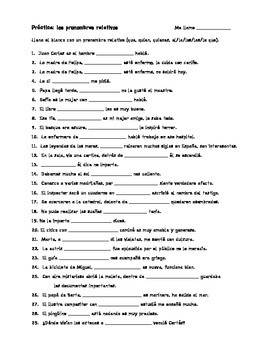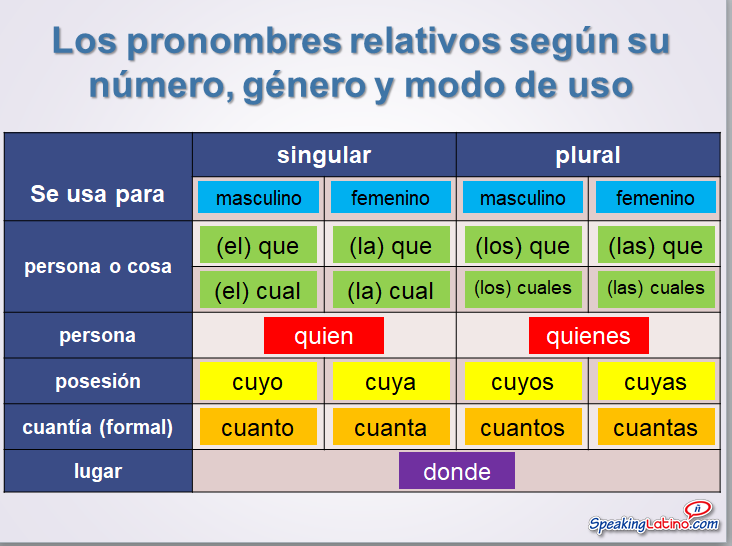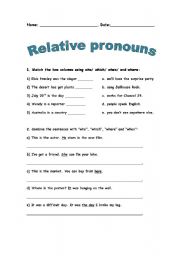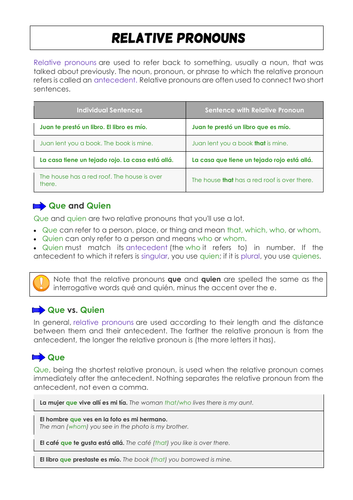How Do Relative Pronouns Work In Spanish
Because relative pronouns often act as triggers and can help you identify where and when to use present subjunctive Spanish. My mother is an excellent cook.

Relative Pronouns In Spanish Using Que Quien Quienes Etc In Relative Clauses Youtube
They modify nouns and pronouns providing a description or information.

How do relative pronouns work in spanish. El hombre cuya madre murió escribió su. The car whose lights do not work is a danger. Pronouns are a part of language used to refer to someone or something without using proper nouns.
A relative pronoun is one that introduces an adjective clause also called a relative clause. When it comes to types of pronouns you should be familiar with what they look like and how theyre used. Note that the adjective agrees in number and gender with the thing being owned not with the owner.
Spanish pronouns in some ways work quite differently from their English counterpartsSubject pronouns are often omitted and object pronouns can appear either as proclitics that come before the verb or enclitics attached to the end of it in different linguistic environments. My mother is thinking of opening a restaurant. But how do you use them.
A non-restrictive relative clause can modify a single noun a noun phrase or an entire proposition. It needs a noun to refer to which is called its antecedent. There is also regional variation in the use of pronouns particularly the use of the informal second-person singular vos.
The simplest definition of a noun is a thing and nouns are the basic building blocks of sentencesThese things can represent a person animal place idea emotion almost any thing that you can think ofDog Sam love phone Chicago courage and spaceship are all nouns. The more nouns you know in a language the better you will be able to communicate your ideas. Direct Object Pronouns at Work.
El Día de Muertos El Presente Adjetivo Nombre Género femenino Gender of nouns in Spanish. Although they look very similar to the Spanish interrogative pronouns Qué Cuándo Dónde Quién there is also a subtle difference in appearance and the meaning and function are different. Adjective clauses or relative clauses are groups of words that contain a subject and a verb and provide further description.
Adjective clauses begin with relative pronouns including. Learn this and more with a helpful guide. Learn everything you need to know with this guide.
As explained below the acute accent often changes the vowel sound in Portuguese but not Spanish. When the indirect objects toi et Marie are replaced by vous there is no preposition visibleHowever if you look up the verb dire in the dictionary it will say something like to tell someone something dire quelque chose à quelquun. Announcements Spanish Language and Culture with Barbara Kuczun Nelson was formerly known as Spanish.
A direct object pronoun can take the place of a direct object referring to a person. Commas are always used at the beginning and end of this type of relative clause. It asks me to change to my home directory using a relative pathname and not using cd by itself with no arguments.
Relative pronouns - English Grammar Today - a reference to written and spoken English grammar and usage - Cambridge Dictionary. La niña cuyo padre es profesor es muy simpática. Italian relative pronounspronomi relativiare called as such because in addition to substituting for the noun they connect or relate two clausesThe clause introduced by the pronoun is subordinate and is dependent on the main clause.
Direct Object Pronouns and People. Used in questions and structures in which there is a fixed or limited set of answers or. Pedro whose sisters are beautiful is my friend.
Relative and interrogative pronouns. In standard English some singular third-person pronouns are he and she which are usually seen as gender-specific pronouns referring to a man and a woman respectivelyA gender-neutral pronoun or gender-inclusive pronoun is one that gives no implications about gender and could be used for. Learn about this famous Medieval warrior with this reading and listening exercise which can help you practise relative pronouns past tenses and past participles as adjectives.
Examine the uses of antecedents learn about pronoun-antecedent. That cannot be used as a relative pronoun in a non-restrictive relative clause. Present Progressive Tense Present Tense Preterite Tense Preterites w Irregular Meanings Preterite vs Imperfect Pronouns DO Pronouns IO Pronunciation Reflexive Verbs Relative Pronouns Saber vs Conocer Ser vs Estar Sequence of Tenses Si.
Lets take a look at how direct object pronouns can do the work of direct objects in Spanish sentences. The relative pronouns in Italian are chi che cui and il qualeRead on to learn how these important pronouns are used in this Romance language. Spanish uses an acute accent on interrogative pronouns while the corresponding relative pronouns etymologically the same words are spelled without the accent to mark the difference in prosodic stress.
Los pronombres indefinidos no se refieren a ninguna persona cosa lugar ni cantidad específicaPor eso se llaman indefinidos. A relative pronoun is used to connect a clause or phrase to a noun or pronoun. Thus the French preposition is implied and the person you are telling you is in fact an indirect object while the thing being told the truth is the.
In your directory if you do ls -a it will list all subdirectories including the two special directories. Pedro cuyas hermanas son guapas es mi amigo. What is a Noun.
Ya hemos visto algunos de los indefinidos relacionados a cantidad en la lección de cuantificadoresA continuación tienes una lista completa con ejemplos de los pronombres indefinidos y las reglas gramaticales de su uso. The relative pronouns are that which who whom and whose An adjective clause sits after a noun to identify it or tell us some information about it. Connect and share knowledge within a single location that is structured and easy to search.
In the first sentence below the direct object is mi mamá. A pronoun is a word that can take the place of a noun.

Spanish Relative Pronoun Practice Worksheet By Jennifer Elizabeth

Spanish Relative Pronouns Video Lesson Transcript Study Com

Relative Pronouns Spanish Class Activities

Spanish Relative Pronoun Practice Worksheet By Jennifer Elizabeth

How To Use Relative Pronouns In Spanish The Easy Way Tips And Tricks

Relative Pronouns Multiple Choice Spanish Worksheet Tpt

Relative Pronouns Where Which Who Worksheet

Circling And Writing Relative Pronouns Worksheet Relative Pronouns Pronoun Worksheets Pronoun

Spanish Relative Pronoun Practice Worksheet On Que Vs Quien Tpt

Quiz Worksheet Spanish Relative Pronouns Study Com
Spanish Relative Pronouns Grammar Notes Exercices And Translations Teaching Resources

Click To Close Or Click And Drag To Move Relative Pronouns Personal Pronouns Worksheets Pronoun Worksheets

Relative Pronouns Spanish Matching Exam By English And Spanish Language Ideas

Relative Pronouns Spanish Multiple Choice Exam Teaching Resources

Relative Pronouns Spanish Fill In The Blanks Exam With Ak As Amped Up Learning

Relative Pronouns Spanish Multiple Choice Exam Tpt

Spanish Relative Pronoun Practice Worksheet By Jennifer Elizabeth

Relative Pronouns Esl Worksheet By L4ur4

Spanish Bellwork Practice Worksheet On The Relative Pronoun Cuyo
